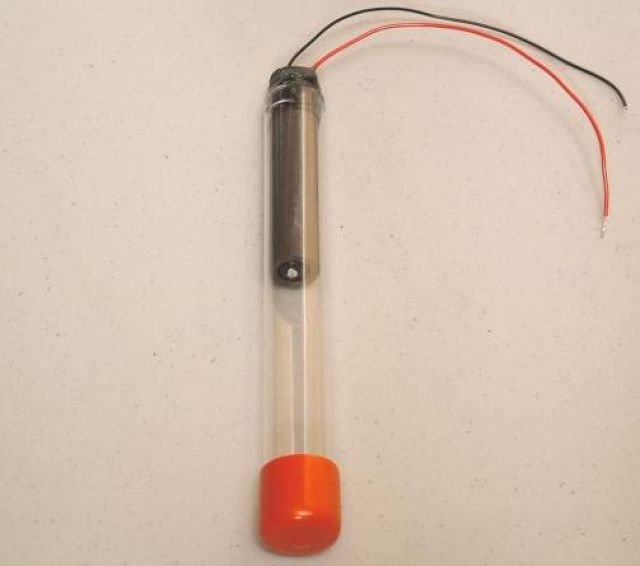
Nu Energy™ Sodium Chloride Ion-valve
Technology

Nu Energy™ Sodium Chloride ion-valve Proof-of-Concept
The original fundemental
Perreault Ion-valve principle was discovered in 1988 and was pubicly announced in 1995. It
utilized a minute amount of radium salt. Calcium chloride (used to chlorinate swimming
pools) was explored as a possible non-radioactive substitute. This substitute proved to be
too reactive and poor results were obtained. Thanks to Walter Hofmann, sodium chloride is
now used as a working substitute in the ion-valve. This is a result of his "water
cell" research, to which Mr. Bruce A. Perreault is forever grateful. This has allowed
the development of a non-radioactive ion-valve. The original design generated more power
but its radioactivity is violently opposed in this day and age. Perhaps, sometime in the
future when fossel fuels are depleted it will be better received.
The structure of a Nu
Energy™ sodium chloride ion-valve is very simple and is similar to a conventional
store bought battery. However, this is where the simularity stops. What makes the Nu
Energy™ sodium chloride ion-valve unique is the fact that it does not contain an acid
or alkaline solution. Batteries that you buy from a store are too acidic or alkaline and
this is what causes them to die out quickly. Instead, a .05% saline (sodium chloride)
solution is used in our product serving as its ion transport vehicle. When it is first
assembled a protective black oxide layer forms that protects it from destructive corrosion
with the solution. This oxide layer is porous and allows a minute reaction to occur
between the alloy and saline solution. This reaction generates a potential difference
between the carbon cathode cylinder and alloy anode rod that allows energy to be
efficiently transported from the sodium chloride ions. The energy that it produced is
believed to come from ambient radiation that ionizes sodium and chlorine molecules within
the solution. A patent is being filed based on Bruce A. Perreault's patent draft.

The anode
alloy that is used in Nu Energy™ sodium chloride ion-valves is similar to an alloy that was used
in the 1950's for welding aluminum. It was called "chemalloy." The difference in the alloy anode
used in a Nu Energy™ sodium chloride ion-valve is that it does not contain toxic
lead. When this alloy is used in the Nu Energy™ sodium chloride ion-valve it does not appear to get used up.
This does not imply that it is a catalyst. Bruce Perreault has been telling people
for years that chemalloy is not a catalyst. The notion that chemalloy is a catalyst is a
myth that has been passed amongst alternative energy researchers. The Nu Energy™ sodium chloride ion-valve is
extremely efficient due to an extremely slow oxidation process.
Newly
assembled cells generate more power at the start and then they level out to a slightly
lower level. Proof-of-concept cells are 8” long x 1” diameter (including
solution vessel) and output around 1.6 volts at 130 milliamps on shunted circuit. This
current at first appears to be small compared to store bought batteries. However, what
must be realized is that store bought batteries do not last long before they have to be
replaced. One test demonstrated that two Nu Energy™ sodium chloride ion-valves
generated ten amp hours of electrical current before the test was halted to check it's
anode for decay. Little decay was found and we can't speculate how long the cells could
have continued generating electrical power. Future longevity tests still need to be
performed. Feedback from proof-of-concept cells will provide more data. This will be
posted as it becomes available.
Nu Energy™ ion-valves are in the
development stage that will utilize a plate design. Increasing cathode surface area
increases available current. Increasing anode surface area has little effect. Nu Energy™ sodium chloride ion-valves can
be combined in series for more voltage and in parallel for more current. There is no
reason why it is not possible to combine enough cells to obtain several hundred watts and
then build their energy up by charging storage batteries to several kilowatts for later
use.
http://www.tinyurl.com/6fqky
"Nuclear batteries can
pack in energy at densities THOUSANDS OF TIMES
greater than those of lithium-ion
batteries"
Energy Content - http://www.tinyurl.com/53roy
What does the Swedish Stone, Moray Valve,
low voltage sodium chloride ion-valve
and high voltage ion-valve
generator all have in common with
each other? They are all radiant energy diode converters.
My original discovery which is a safe and
unique method to create a
synthetic radioactive radioisotope that can be used as an energy source. My ion-valves
will convert this source of energy
efficiently into electrical current. Many circuits can be used to interface with an ion-valve. I do not stake my
claims to the circuitry. I stake
my claims on my method to obtain synthetic radioisotopes without the heat cycle that is associated with modern fission
reactors. My process is safe and
if the correct materials are chosen
toxic elements and compounds are not created.
The Swedish Stone, R.E. Moray Valve and
Perreault Ion-valve are all radioactive diodes. The construction of my ion-valve is
designed with effectiveness and cost considerations. Various designs can be utilized. I do
not stake a claim on the discovery of the diode. I do claim to utilize an effect that has
largely been ignored by mainstream science. The use of radiation at the junction of a
solid-state diode is not new. However, the use of radiation in a vacuum or gas diode
appears to be unique.
This is the solution to our energy
independence in my opinion.
-Bruce A. Perreault
November
08, 2004
 ™
™
Nu
Energy Research Laboratories
Nu Energy Horizons, P. O. Box 22, Rumney, New Hampshire 03266-0022 USA
Copyright © 2004, All Rights Reserved






 ™
™